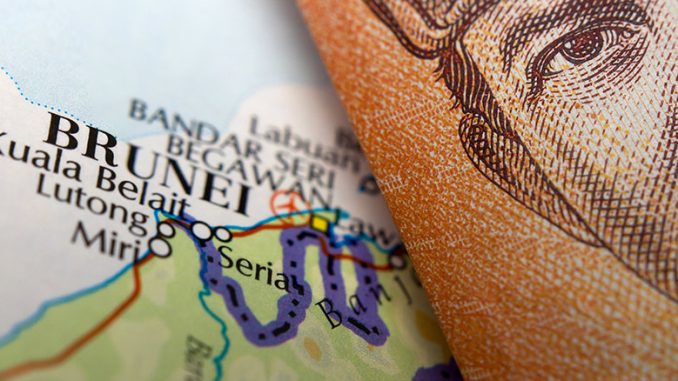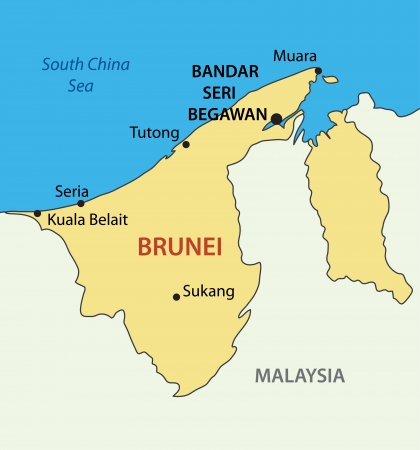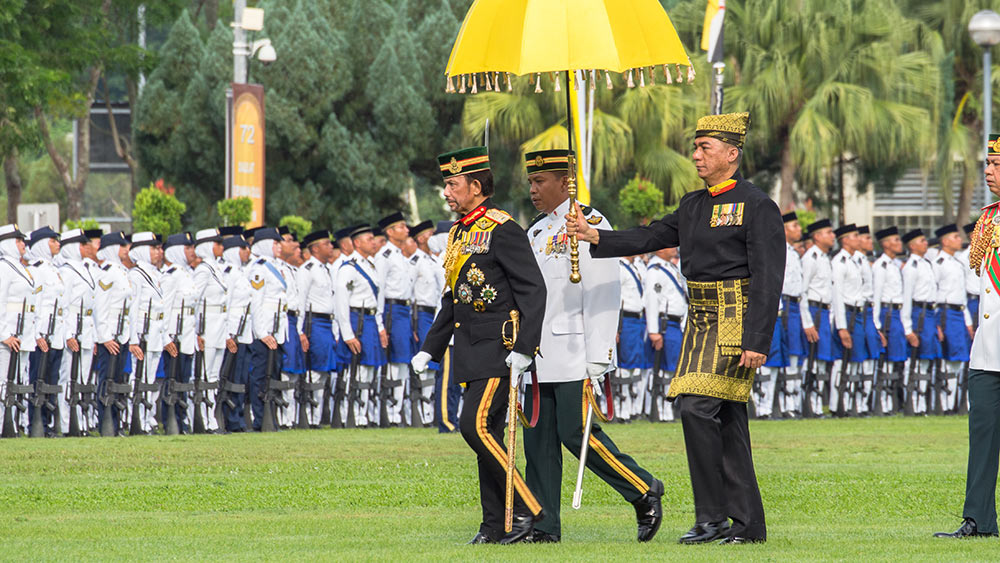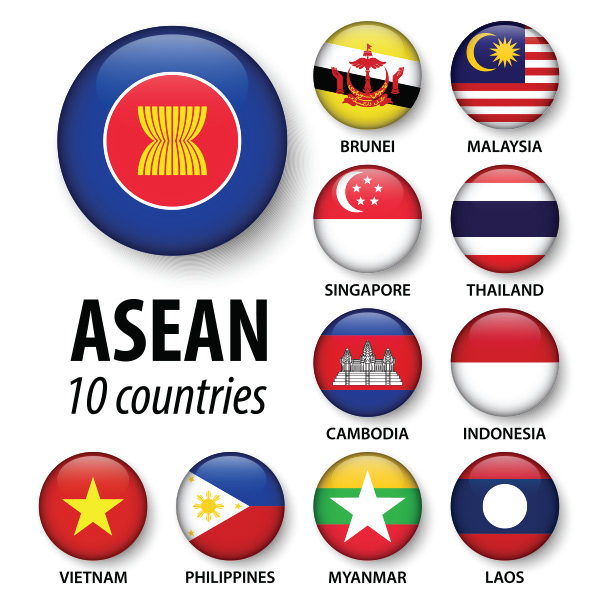
From Brunei’s vantage point, the security outlook in 2019 was relatively peaceful and optimistic on the region’s capabilities in managing security challenges. While relations between ASEAN and other parts of the world has been progressing, however, Brunei is aware that there are challenges as uncertainties loom over regional security. 1 Since independence, Brunei’s key security challenges traditionally derived from external threats such as political legitimacy, territorial borders, maritime dispute and national sovereignty. 2 However, in the post-Cold War, Brunei’s security perception has broadened as there have been multiple mediating factors that drives its security policies, as non-traditional security threats such as cyber-security, HADR, human trafficking, and illegal fishing has not only affect state security but also human security. 3
Similar to other ASEAN states, security challenges for Brunei derives from regional uncertainties which Southeast Asia is emerging as a flashpoint due to changes in the geo-strategic landscape. 4 The ongoing tension between the two great powers vis-à-vis US-China on multitude of issues arising from trade disagreement, freedom of navigation, technological and intelligence challenges and the South China Sea dispute are tumultuous towards the strategic sphere which could potentially be devastating to the region. 5 As the second largest economy in the world, China’s inclination on economic growth concede as a major power in the region, which is gradually transforming the fabric of the political and economic realities.
From the Western perspective, China’s power is generally seen as a threat towards the Western liberal rules-based as China’s foreign policies are becoming more aggressive and becoming a revisionist power. 6 In contrast, Chinese analysts and policymakers perceive that the rules-based order is archaic as US unilateral policies limits China’s potential to be a legitimate regional power. 7 Over the past decade, China has continued to modernize its military capabilities by investing sophisticated weaponry as well as the militarization of islands in the South China Sea. China’s recent showcase on its intermediate-range ballistic, the DF-26 missiles military parade demonstrated its capabilities of reaching US critical bases in the region has bolster itself as an emerging dominant power in the region. 8 However, in response the US military spending has dramatically increased from US$560 billion in 2015 to US$686 billion in 2019 setting it to near historic highs. 9

Prominent scholars such as Graham Allison and political figures argue that the current power competition between the great powers could potentially lead to heightened conflict ‘Thucydides trap’. 10 However, such simplification of describing U.S-China relations should be debunked. The current trajectory on the political reality show that the Thucydides trap is hawkish and unclear. It distorts and oversimplify the pathway process on how great powers conflict could lead to an all-out war. It is important to note despite the rising tension it would be completely erroneous to ignore that both China and the US are deeply intertwined in the international system as both great powers are bound by complex overlap of bilateral and multilateral consensus and it is each other’s biggest trade partners and investors. 11 The risk to be engaged in an all-out war would be too costly for its economy and politically in the international society. As a show of restraint, China’s militarization of islands in the South China Sea came to a halt, suggesting that the Chinese counterparts are willing to cooperate within the rules-based order without significantly challenging the primacy of the US. 12
Political tension and potentially antagonizing relations between the great power poses a huge risk as the debacle has serious implications towards the slow global economic growth as well as strategic uncertainties. According to the IMF, in 2019 global economic growth continues to slow down as a result of the Sino-US trade war. 13 The regional strategic uncertainties are potentially concerning to Brunei’s national sovereignty. Amidst the US-China trade war, ASEAN states are anxious over the magnitude of political and economic devastation and its impact to global economic slowdown. As a major oil exporter, uncertainties over global oil prices have hugely affect its economy. For Brunei, it is inevitable that the rise of China’s influences changed the regional order which contribute to an array of security challenges that the Asia-Pacific encounters. Brunei perceive that China could also potentially be a responsible stakeholder that could provide prosperity and elevate ASEAN from emerging economy to more advance and technologically-driven economy, competing with the advanced European economy. 14
Sharing the same purview with other ASEAN counterparts, Brunei perceive that maintaining bilateral and multilateral engagements with major powers remains its diplomatic priorities, as both great powers are major players in its security framework for political stability and economic growth. 15 More importantly, the hardening stances by both great powers may prompt regional rivals which could further fuel militarization, risking escalation that could potentially split the regional bloc as member states face growing pressure to take sides. 16 As ASEAN constitutes of extremely diverse national groupings, the deepening cleavages within members caused by great power competition can be potentially destabilizing Brunei’s security and economy. ASEAN led rules-based order should take center stage in managing competition as historically, ASEAN has been able largely capable to maintain open economies and political stability. 17 However, the ASEAN way of conducting and managing great power relations have been challenged in recent times. The increasing tension between both great powers have also created deep division and disintegration between the ASEAN members. Such security engagements come as a competition as both great powers are jostling for influence in the region. For Brunei, ASEAN must evolve to accommodate China as an emerging power rather than a revisionist state.

As a group of small and medium powers that gained independence after the World War II, most states in ASEAN suffers the postcolonial challenges of weak economies and divided societies, creating internal as well as external strategic constraints. 18 For Brunei, economic security and promoting ASEAN regional order remains pivotal towards maintaining regional stability and national sovereignty. Challenges from the great power competition is no stranger to the region. Nevertheless, ASEAN’s experiences and resilience in dealing with great power competition has been transformative and remained focus in managing as a regional conductor in reducing political rhetoric and promote deeper strategic trust. 19 The uncertain relationship between the US and China will remain as an implicit factor in shaping the stability of the Asia-Pacific region, particularly of Southeast Asian countries in the coming decades. Historically, Southeast Asia was a hotbed for major European imperialist powers in competition for the importance of trade route and access to agrarian commodities and natural resources. 20 During the Cold War, ASEAN also became the epicenter for strategic contest between superpowers. In the post-Cold War era, however, Southeast Asia again found itself at the center of geopolitical shift as new realities have emerged between the US and China.
For Southeast Asia, the current trade wars between the two great powers serves as a double-edged sword. Increasing protectionist policies driven by populist policies creates political instability and uncertainties as countries do not share the same values and cost for limited free trade barriers. 21 While uncertainty may risk military escalation, however, it has also benefited the region as the trade barriers between US and China affected supply chains forcing some multinational companies to relocate its operations from China to Southeast Asia. 22 It has provided ASEAN to be more innovative in its efforts to strengthen cooperation through various platforms supported by its Dialogue Partners and other External Partners, to enhance economic and security cohesiveness in promoting regional peace. 23
Like other members, Brunei has also played its role as a regional member by seeking closer ties with other external partners such as Australia, India and Japan in its efforts to diversify economic and strategic dependencies. In 2019, Brunei signed with Lurssen as part of joint-venture defense deal that would spur modernization on its civilian manufacturing industry. 24 Moreover, as part of the US decision to pull out from the CTTPP in 2017, ASEAN leaders has sharpened its focus to exercise its role to pursue RCEP as a more inclusive regional framework that includes some of the biggest economies in the world. ASEAN’s role is pivotal because should this proposed free-trade comes to an agreement, the regional bloc has the opportunity to offset further interdependence preventing the rise of populist and protectionist policies across the globe. 25

Moving Forward
Nonetheless, ASEAN states have always been skillfully managed to adopt hedging behaviors and strategic alignments as a spectrum of policy options in a more realistic way to observe continuity and change on security challenges. 26 For the past 52 years, ASEAN became central in managing both intra–Southeast Asian transitions and external relations with great powers. Within the subregion, the ASEAN belief in achieving regional security through regional resilience understood as forging regional unity which forestall external intervention and ensure autonomy was expanded to realize Southeast Asian integration. 27
In the security realm, ASEAN states have also been modernizing its military. Fueled by high economic growth in the post-Cold War, Brunei has also begun to increase its military capabilities in parts to replace their ageing assets and to meet the security challenges that the region is facing. 28 The blurring lines of traditional and non-traditional security threats also meant that states are investing more prudently on multi-role combat capabilities in meeting these security challenges. As part of its regional integration, Brunei has used the military modernization as part of its defense diplomacy to provide a valuable sociopolitical capital for extra-regional powers to engage on sensitive issues. 29 During the ADMM meeting held in Bangkok in July 2019, ASEAN members agreed to extend the ASEAN Direct Communication Infrastructure (ADI) which is the regional grouping’s secured hotline for rapid direct communication to other Asia Pacific partnering countries. As part of Brunei’s milestone in deepening regional peace and security, during its chairmanship in 2013 the ADI was introduced as part of confidence building measures to boost information sharing and reduce the risk of miscalculations and escalations. 30
In 2018, all 10 ASEAN members and the Chinese counterpart held its first maritime exercise to boost security ties as well as building common understanding between ASEAN and China. The security exercise plays a huge significance to the region as it represents that China is keen to maintain regional stability amidst the security uncertainties. 31 China is also seeking to conclude the Code of Conduct during Brunei’s Chairmanship in 2021. 32 This is quite significant diplomatically and strategically as four of the ASEAN members have overlapping claims with China. On the other hand, continuing US presence in the region has been pivotal for ASEAN as it is seen as a security guarantor for the region to maintain peace. 33 The US also provides a security platform for ASEAN to grow and emerge as one of the most economically competitive regions in the world. The US military has a history of long-standing military relations, by actively holding annual and biennial multilateral military exercises with a host of ASEAN members over the years, such as CARAT, Cobra Gold, RIMPAC and SEACAT. In 2019, the US Department of Defense conducted the ASEAN-US Maritime Exercise which included all members of ASEAN even though the US imposed sanctions on Myanmar. This demonstrates that the US is willing to participate by improving multilateral ties signaling its intention to widen its security network with ASEAN. 34
Such implication provides a very optimistic outlook for the Asia-Pacific region as both great powers recognizes the importance of ASEAN as a regional bloc that emphasizes its centrality and consensus building. Given these recent developments, Brunei perceives that ASEAN has the potential and capacity to accommodate both great powers to co-exist and enhance the regional order. In his recent Titah, His Majesty the Sultan of Brunei shared his view that ASEAN must be proactive in promoting a robust structure of multilateralism and more vocal against protectionism in coordination with the rules-based order. 35 Moving forward, Brunei is at a unique position to enhance regional cooperation on the basis of the ASEAN platform to overcome threats and uncertainties that pose to the security of the region.
Hafiizh Hashim
Hafiizh Hashim is a PhD Candidate at the University of Bristol, UK
Email: fiiz_311@hotmail.com
Notes:
- Brunei Defence White Paper, Defending the Nation’s Sovereignty: Expanding Roles in Wider Horizons (MINDEF Brunei, 2011). ↩
- Brunei Defence White Paper, Defending the Nation’s Sovereignty: Expanding Roles in Wider Horizons (MINDEF Brunei, 2011). ↩
- Titah by His Majesty, the Sultan of Brunei During 55th RBAF Anniversary, May 31 (2016), http://mindef.gov.bn/Titah/31st%20May%202016%20-%2055th%20RBAF%20Anniversary.pdf ↩
- Plenary Session of the 28th ASEAN Summit, Prime Minister Office, Brunei, September 06 (2016), http://www.pmo.gov.bn/Lists/News/DispForm.aspx?ID=795; Evelyn Goh, “Southeast Asia’s Evolving Security Relations and Strategies,” in Oxford Handbook of the International Relations of Asia, ed. Saadia Pekkanen, John Ravenhill, and Rosemary Foot (Oxford: Oxford University Press, 2014), 462–80. ↩
- Robert Ross, “US Grand Strategy, the Rise of China, and US National Security Strategy for East Asia,” Strategic Studies Quarterly 7, no. Summer (2013): 20–40. ↩
- Aaron L Friedberg, “Competing with China,” Survival 60, no. 3 (2018): 7–64; US Senate Committee on Foreign Relations, Menendez, Markey, Leahy, Schatz urge Pompeo to address China’s maritime aggression at ASEAN SUMMIT, July 30, 2019, https://www.foreign.senate.gov/press/ranking/release/menendez-markey-leahy-schatz-urge-pompeo-to-address-chinas-maritime-aggression-at-asean-summit ↩
- Yongjin Zhang, “China and the Struggle for Legitimacy of a Rising Power,” The Chinese Journal of International Politics 8, no. 3 (2015): 301–22; Feng Zhang, “Chinese Thinking on the South China Sea and the Future of Regional Security,” Political Science Quarterly 132, no. 3 (2017): 435–66; For most recent China Defense Paper, see, The State Council Information Office, China’s National Defense in the New Era, 24 July, 2019, http://www.xinhuanet.com/english/2019-07/24/c_138253389.htm ↩
- Minnie Chan and Liu Zhen, “China rolls out new weapon systems, nuclear-capable missiles in military parade” South China Morning Post, October 1 (2019), https://www.scmp.com/news/china/military/article/3031145/china-rolls-out-new-weapon-systems-nuclear-capable-missiles ↩
- US Department of Defense, “FY 2019 Defense Budget” (2019): https://dod.defense.gov/News/SpecialReports/Budget2019.aspx ↩
- Graham Allison, “The Thucydides Trap” (The Atlantic, 2015), https://www.hks.harvard.edu/sites/default/files/centers/mrcbg/files/Allison%2C 2015.09.24 The Atlantic – Thucydides Trap.pdf. ↩
- Laura Zhou, “China, US too intertwined to ‘break up’ despite trade war, Xi Jinping says in Russia, South China Morning Post, June 8, (2019), https://www.scmp.com/news/china/diplomacy/article/3013659/china-us-too-intertwined-break-despite-trade-war-xi-jinping ↩
- Zhao Yusha, “Land reclamation to expand in South China Sea islands: expert”, Global Times, February 5, (2018). http://www.globaltimes.cn/content/1088347.shtml ↩
- World Economic Outlook Reports, “World Economic Outlook, October 2019, Global Manufacturing Downturn, Rising Trade Barriers” IMF, (2019), https://www.imf.org/en/Publications/WEO/Issues/2019/10/01/world-economic-outlook-october-2019 ↩
- Stephen C. Druce and Abdul Hai Julay, “The Road to Brunei’s Economic Diversification: Contemporary Brunei-China Relations” in China and Southeast Asia in the Xi Jinping Era, ed. Alvin Cheng-Hin Lim and Frank Cibulka (London: Lexington Books), 139-152. ↩
- Ministry of Foreign Affairs Brunei, Foreign Policy, (2019), http://www.mfa.gov.bn/Pages/Foreign%20Policy.aspx ↩
- Marty Natalegawa, Does ASEAN Matter? A View from Within, (Singapore: ISEAS, 2018) ↩
- Richard Stubbs and Sorin Mitrea, “Contemporary Politics ASEAN At 50: The Global Political Economy’s Contribution to Durability,” Contemporary Politics 23, no. 4 (2017): 388–407. ↩
- Mark Beeson, “Can ASEAN Cope with China?,” Journal of Current Southeast Asian Affairs, vol. 1, 2016. ↩
- Robert Yates, “ASEAN as the ‘Regional Conductor’: Understanding ASEAN’s Role in Asia-Pacific Order,” The Pacific Review 30, no. 4 (2017): 443–61. ↩
- Kei Koga, “ASEAN’s Evolving Institutional Strategy: Managing Great Power Politics in South China Sea Disputes,” The Chinese Journal of International Politics 11, no. 1 (2018): 49–80. ↩
- Marty Natalegawa, Does ASEAN Matter? A View from within (Singapore: ISEAS, 2018). ↩
- Kevin Stankiewicz, “US economy being hit harder by the trade war than China, Influential Asian financier”, CNBC, October 14 (2019), https://www.cnbc.com/2019/10/14/pag-chairman-weijian-shan-us-being-hit-harder-by-trade-war-than-china.html ↩
- Ministry of Foreign Affairs Thailand, ASEAN’s External Relations http://www.mfa.go.th/asean/en/organize/62217-ASEAN%E2%80%99s-External-Relations.html ↩
- Stephen Kruper, “Lurssen secures long-term Asia-Pacific sustainment contract” Defense Connect, March 15 (2019). ↩
- Thana Boonlert, “Trade spat will not affect RCEP: ASEAN, Bangkok Post, October 7 (2019), https://www.bangkokpost.com/business/1766264/trade-spat-will-not-affect-rcep-asean ↩
- Ann Marie Murphy, “Great Power Rivalries, Domestic Politics and Southeast Asian Foreign Policy: Exploring the Linkages,” Asian Security 13, no. 3 (2017): 165–82. ↩
- Marty Natalegawa, Does ASEAN Matter? A View from Within, (Singapore: ISEAS, 2018). ↩
- Brunei Defence White Paper, Defending the Nation’s Sovereignty: Expanding Roles in Wider Horizons (MINDEF Brunei, 2011). ↩
- Rasidah Hj Abu Bakar, “MINDEF budget to focus on promoting defence diplomacy, improving capabilities” The Scoop, March 13 (2019), https://thescoop.co/2019/03/13/mindef-budget-to-focus-on-promoting-defence-diplomacy-improving-capabilities/ ↩
- Aziz Idris, “13th ADMM ends on a high note”, Borneo Bulletin, July 13 (2019), https://borneobulletin.com.bn/13th-admm-ends-high-note/ ↩
- Hoang Thi Ha, “ASEAN-China Maritime Exercise is not a Zero-Sum Game”, ISEAS Commentaries, October 25 (2018), https://www.iseas.edu.sg/medias/commentaries/item/8451-aseanchina-maritime-exercise-is-not-a-zerosum-game-by-hoang-thi-ha ↩
- Xinhua, “China hopes to complete talks on S. China Sea code of conduct in 3 years” Xinhuanet, November 13 (2018) http://www.xinhuanet.com/english/2018-11/13/c_137603619.htm ↩
- Felix Heiduk, “An Arms Race in Southeast Asia? Changing Arms Dynamics, Regional Security and the Role of European Arms Exports,” 2017, https://www.swp-berlin.org/fileadmin/contents/products/research_papers/2017RP10_hdk.pdf. ↩
- Tang Siew Mun and Glenn Ong, “Takeaways from the inaugural ASEAN-US Maritime Exercise (AUMX), ISEAS Commentaries, October 1 (2019), https://www.iseas.edu.sg/medias/commentaries/item/10447-takeaways-from-the-inaugural-aseanus-maritime-exercise-aumx-by-tang-siew-mun-and-glenn-ong ↩
- ASEAN tingkatkan kerjasama serantau, antarabangsa, Pelita Brunei, (2019) http://www.pelitabrunei.gov.bn/Lists/Berita%202018/NewDisplayForm.aspx?ID=15979 ↩
